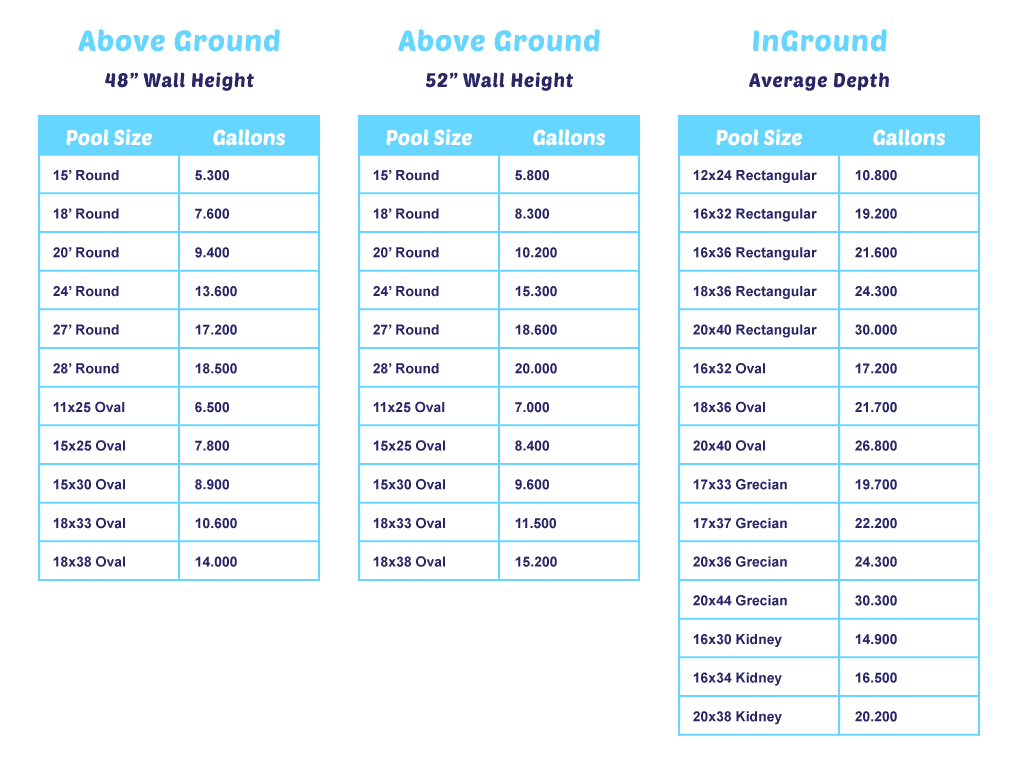

To get the radius squared, you’ll multiply the radius by itself: On a round pool, they’re all the same number. You can also call this its width or length. Start by measuring your pool’s diameter, which is measured at its widest point. It looks like this:īut before you can solve that equation, you need to find the radius of the pool. To find a round pool’s volume in gallons, you’ll multiply Pi by the radius squared, by the depth, by 7.5. Once you have the volumes of both parts, simply add them together to determine the volume for the whole pool. This will allow you to apply the volume of each section using the constant depth formula. It may be easier, in this case, to treat the shallow and deep ends as separate pools. If, instead of a gradual slope down to the deep end, your pool has a definitive drop between the shallow and deep ends, the average depth will be different, even if the shallow end and deep end are still, for example, 3 feet and 9 feet, respectively. Let’s assume your pool is 32 feet long, 16 feet wide, and has an average depth of 6 feet:ģ2 × 16 × 6 × 7.5 = 23,040 gallons Variable Depths with a Drop-Off Then multiply that figure by 7.5 to calculate the volume of the pool in gallons. Then you’ll multiply that number by the average depth to calculate the volume in cubic feet. Next, measure the length and width to calculate the surface area of the pool. (shallow D + deep D) ÷ 2 = average D (in feet)įor example, let’s say your pool’s shallow end is 3 feet, and the deep end is 9 feet: To do this, add the shallow end depth to the deep end depth, and divide by 2. First, determine the pool’s average depth. If your pool has more than one depth (shallow end, deep end), you’ll need to do a little more math. So if your pool is 32 feet long, 16 feet wide, and 4 feet deep:ģ2 × 16 × 4 × 7.5 = 15,360 gallons Variable Depths with a Gradual Slope Then you’ll multiply that number by the depth to calculate the volume in cubic feet.

If your pool has only one depth, you’ll measure the length and width to calculate the surface area of the pool. How you calculate volume will depend on how the bottom of your pool is laid out. It’ll reveal everything you need to know about taking care of any size pool with ease. If any of this is confusing, then you should invest in the pool care video course. Now it’s just a matter of plugging in the numbers. So in order to determine the total number of gallons your pool holds, you’ll first determine the cubic feet measurement of your pool, then multiply that number by 7.5 to find the volume. To ensure those calculations are correct, divide your pool into sections by depth (shallow end, deep end).Īnother key part of your equations is this: One cubic foot of water contains 7.5 gallons. In order to calculate cubic volume, you’ll need to include the pool’s depth as well as the surface area. In order to measure your pool’s volume, you’ll need a handful of basic equation elements.Īnd just in case geometry class was a while ago for you, a few basic formulae to calculate area:Īrea of a Right Triangle: A = (L × W) ÷ 2 It’s not enough to throw the chemistry balance off. It rounds up just a bit, which will make chemical calculations easier. To use your pool’s exact measurements, you can also use our pool calculator. Just be aware that the measurements and amounts may not be exact, depending on your pool’s size, and you’ll always get a better result if you measure your pool yourself.
#POOL MATH CALCULATOR HOW TO#
How to Calculate Pool Volumeīefore you do any math or use a pool calculator, you can also just use this quick-reference chart. Even if it’s not just a rectangle or a circle, all you have to do is plug your pool’s measurements into a mathematical formula to get the volume.īut if you’re not into math or, as we like to call it, numerical torture, you can just as easily plug those numbers into a pool calculator and let it do the work for you. The necessary amounts of chlorine, pH increaser, shock, and any other chemical you use to care for your pool have all been figured out based on water volume. That includes adding chemicals to your pool. This means they’ve navigated the pitfalls and figured some things out so you don’t have to. Luckily for you, lots of people have been maintaining pools for decades now.

And if you don’t already know that, it’s time to break out the pool calculator. But those instructions only work if you know how much water your pool holds. It’s always a good idea to follow the manufacturer’s instructions when adding chemicals to your pool water. The more water it holds, the more chemicals you’ll need to keep it clean and swimmable. Before you go pouring a bunch of chemicals into your pool, you need to know how much to use.


 0 kommentar(er)
0 kommentar(er)
